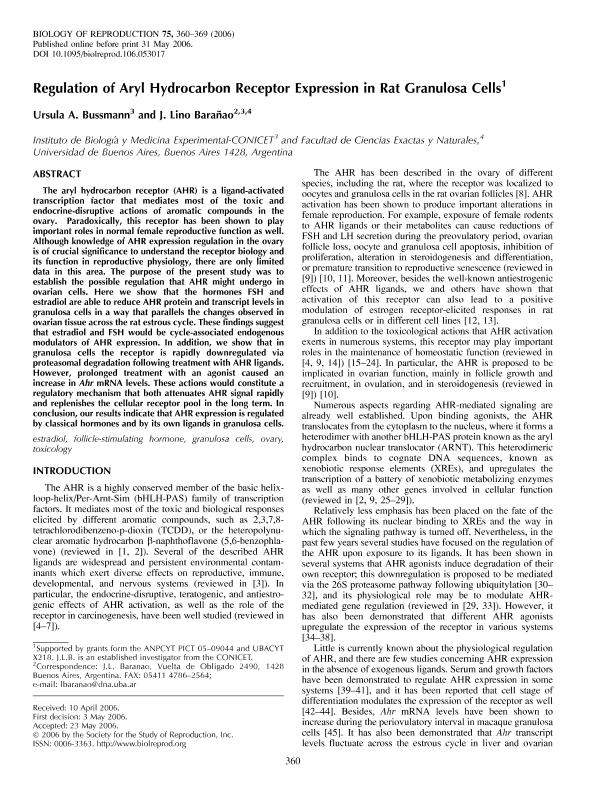Mostrar el registro sencillo del ítem
dc.contributor.author
Bussmann, Ursula Agnes

dc.contributor.author
Barañao, Jose Lino Salvador

dc.date.available
2017-06-21T15:34:04Z
dc.date.issued
2006-05-31
dc.identifier.citation
Bussmann, Ursula Agnes; Barañao, Jose Lino Salvador; Regulation of aryl hydrocarbon receptor expression in rat granulosa cells; Society For The Study Of Reproduction; Biology Of Reproduction; 75; 3; 31-5-2006; 360-369
dc.identifier.issn
0006-3363
dc.identifier.uri
http://hdl.handle.net/11336/18531
dc.description.abstract
The aryl hydrocarbon receptor (AHR) is a ligand-activated transcription factor that mediates most of the toxic and endocrine-disruptive actions of aromatic compounds in theovary. Paradoxically, this receptor has been shown to play important roles in normal female reproductive function as well. Although knowledge of AHR expression regulation in the ovary<br />is of crucial significance to understand the receptor biology and its function in reproductive physiology, there are only limited data in this area. The purpose of the present study was to<br />establish the possible regulation that AHR might undergo in ovarian cells. Here we show that the hormones FSH and estradiol are able to reduce AHR protein and transcript levels in granulosa cells in a way that parallels the changes observed in ovarian tissue across the rat estrous cycle. These findings suggest that estradiol and FSH would be cycle-associated endogenous modulators of AHR expression. In addition, we show that in granulosa cells the receptor is rapidly downregulated via proteasomal degradation following treatment with AHR ligands. However, prolonged treatment with an agonist caused an increase in Ahr mRNA levels. These actions would constitute a regulatory mechanism that both attenuates AHR signal rapidly and replenishes the cellular receptor pool in the long term. In conclusion, our results indicate that AHR expression is regulated by classical hormones and by its own ligands in granulosa cells.
dc.format
application/pdf
dc.language.iso
eng
dc.publisher
Society For The Study Of Reproduction

dc.rights
info:eu-repo/semantics/openAccess
dc.rights.uri
https://creativecommons.org/licenses/by-nc-sa/2.5/ar/
dc.subject
Aryl Hydrocarbon Receptor
dc.subject
Estradiol
dc.subject
Follicle-Stimulating Hormone
dc.subject
Granulosa Cells
dc.subject
Ovary
dc.subject
Toxicology
dc.subject.classification
Biología Reproductiva

dc.subject.classification
Ciencias Biológicas

dc.subject.classification
CIENCIAS NATURALES Y EXACTAS

dc.title
Regulation of aryl hydrocarbon receptor expression in rat granulosa cells
dc.type
info:eu-repo/semantics/article
dc.type
info:ar-repo/semantics/artículo
dc.type
info:eu-repo/semantics/publishedVersion
dc.date.updated
2017-05-16T20:33:18Z
dc.identifier.eissn
1529-7268
dc.journal.volume
75
dc.journal.number
3
dc.journal.pagination
360-369
dc.journal.pais
Estados Unidos

dc.journal.ciudad
Nueva York
dc.description.fil
Fil: Bussmann, Ursula Agnes. Consejo Nacional de Investigaciones Científicas y Técnicas. Instituto de Biología y Medicina Experimental. Fundación de Instituto de Biología y Medicina Experimental. Instituto de Biología y Medicina Experimental; Argentina. Universidad de Buenos Aires. Facultad de Ciencias Exactas y Naturales; Argentina
dc.description.fil
Fil: Barañao, Jose Lino Salvador. Consejo Nacional de Investigaciones Científicas y Técnicas. Instituto de Biología y Medicina Experimental. Fundación de Instituto de Biología y Medicina Experimental. Instituto de Biología y Medicina Experimental; Argentina
dc.journal.title
Biology Of Reproduction

dc.relation.alternativeid
info:eu-repo/semantics/altIdentifier/url/https://academic.oup.com/biolreprod/article-lookup/doi/10.1095/biolreprod.106.053017
dc.relation.alternativeid
info:eu-repo/semantics/altIdentifier/doi/http://dx.doi.org/10.1095/biolreprod.106.053017
Archivos asociados
